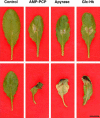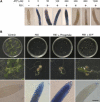Extracellular ATP functions as an endogenous external metabolite regulating plant cell viability
- PMID: 16199612
- PMCID: PMC1276027
- DOI: 10.1105/tpc.105.036806
Extracellular ATP functions as an endogenous external metabolite regulating plant cell viability
Abstract
ATP is a vital molecule used by living organisms as a universal source of energy required to drive the cogwheels of intracellular biochemical reactions necessary for growth and development. Animal cells release ATP to the extracellular milieu, where it functions as the primary signaling cue at the epicenter of a diverse range of physiological processes. Although recent findings revealed that intact plant tissues release ATP as well, there is no clearly defined physiological function of extracellular ATP in plants. Here, we show that extracellular ATP is essential for maintaining plant cell viability. Its removal by the cell-impermeant traps glucose-hexokinase and apyrase triggered death in both cell cultures and whole plants. Competitive exclusion of extracellular ATP from its binding sites by treatment with beta,gamma-methyleneadenosine 5'-triphosphate, a nonhydrolyzable analog of ATP, also resulted in death. The death response was observed in Arabidopsis thaliana, maize (Zea mays), bean (Phaseolus vulgaris), and tobacco (Nicotiana tabacum). Significantly, we discovered that fumonisin B1 (FB1) treatment of Arabidopsis triggered the depletion of extracellular ATP that preceded cell death and that exogenous ATP rescues Arabidopsis from FB1-induced death. These observations suggest that extracellular ATP suppresses a default death pathway in plants and that some forms of pathogen-induced cell death are mediated by the depletion of extracellular ATP.
Figures












References
-
- Beigi, R.D., and Dubyak, G.R. (2000). Endotoxin activation of macrophages does not induce ATP release and autocrine stimulation of P2 nucleotide receptors. J. Immunol. 165, 7189–7198. - PubMed
-
- Boldin, P., and Burnstock, G. (2001). Purinergic signalling: ATP release. Neurochem. Res. 26, 959–969. - PubMed
-
- Bozzo, G.G., Raghothama, K.G., and Plaxton, W.C. (2002). Purification and characterization of two secreted purple acid phosphatase isozymes from phosphate-starved tomato (Lycopersicon esculentum) cell cultures. Eur. J. Biochem. (Tokyo) 269, 6278–6286. - PubMed
MeSH terms
Substances
LinkOut - more resources
Full Text Sources
Other Literature Sources
Molecular Biology Databases

